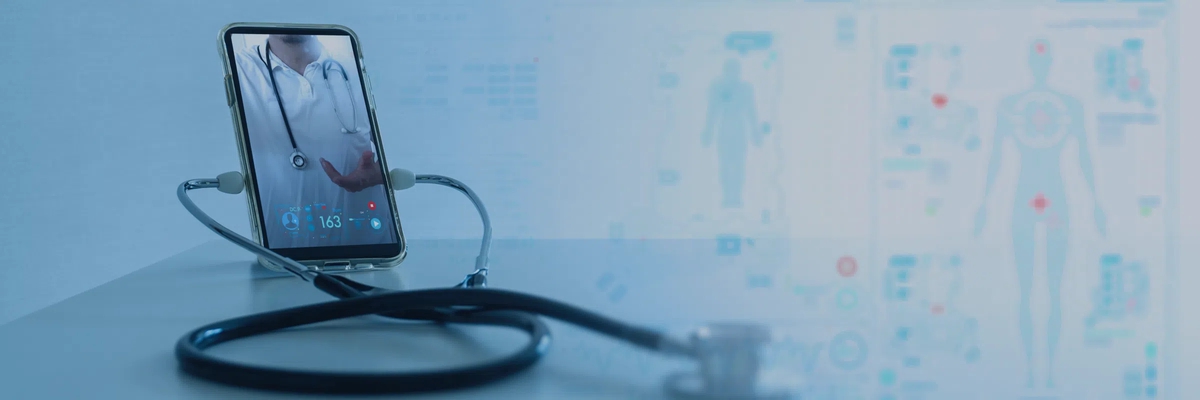Designing for Health: Top Trends in Medical User Interface Design
UX in healthcare is the design of a user's interaction with a healthcare product or service, such as electronic health records, disease management apps, or doctor appointment scheduling apps. In general, UX/UI design in healthcare is not too different from UX/UI design in other industries. It is aimed at creating value for users and attracting and retaining users. However, it has its own peculiarities, which we will consider in the article.
The COVID-19 pandemic has led to an increase in global demand for digital healthcare services. Wearable devices and virtual reality (VR) technologies can significantly improve treatment outcomes, and this adds a new challenge for UX designers — to bridge the gap between technology and patients.
Telemedicine is becoming one of the most useful advances in medical technology. Instead of visiting a doctor's office for a consultation, patients can now be treated remotely using medical apps, remote monitoring tools, and video consultations.
Trends in medical UX/UI in 2024
Here are some of the UX design trends that are likely to influence the future of medicine:
Personalization
In the future, healthcare providers may use data and algorithms to create personalized experiences for patients. By understanding a patient's unique needs, preferences, and medical history, healthcare providers can create more effective treatment plans and improve patient outcomes.
Mobile-friendly design
With the growing popularity of smartphones and other mobile devices, healthcare providers need to design their digital services with mobile in mind. This means creating mobile-friendly interfaces that are easy to navigate and use on small screens.
Virtual and augmented reality
As VR and AR technologies become more sophisticated and affordable, they will play an increasingly important role in healthcare. These technologies can be used to create immersive experiences that help patients better understand their health status, visualize complex medical procedures, and more.
Voice user interfaces (VUI)
With the growing popularity of voice assistants such as Siri and Alexa, VUIs will become an important part of UX design in healthcare. VUIs can be used to create more natural and intuitive interfaces that allow patients to interact with healthcare professionals using their voices.
Wearable technologies
Wearable technologies, such as smartwatches and fitness trackers, will continue to play an important role in healthcare. These devices can be used to collect data on a patient's health status, monitor chronic diseases, and provide feedback on lifestyle choices that may affect health.
User-Centered Design (UCD)
UCD remains a fundamental principle in UI design, emphasizing the importance of understanding the needs, behaviors, and preferences of the end users. Designers are increasingly involving healthcare professionals, patients, and other stakeholders in the design process to create interfaces that truly meet their requirements.
Data Visualization
As healthcare generates and relies on vast amounts of data, effective data visualization is crucial. UIs in medical applications are incorporating interactive and intuitive data visualization techniques to present complex medical information in a comprehensible manner. This includes charts, graphs, and other visual elements. Here are Python libraries for 3D human pose visualization.
Artificial Intelligence (AI) Integration
AI is being integrated into medical UIs to enhance decision support, diagnosis, and treatment planning. Natural Language Processing (NLP) is used for voice commands and text input, and machine learning algorithms can analyze patient data to provide personalized insights.
Gamification for Patient Engagement
Gamification elements are being incorporated into medical interfaces to enhance patient engagement and adherence to treatment plans. This includes the use of rewards, challenges, and interactive features to make healthcare experiences more engaging.
Emphasis on Accessibility
Accessibility in medical UI design is critical to ensure that the interfaces can be used by individuals with diverse abilities. This includes designing interfaces that are compatible with screen readers, have readable text, and provide alternative navigation options.
Telehealth and Remote Monitoring
The rise of telehealth has led to the design of user interfaces that support remote consultations and monitoring. Intuitive interfaces for both healthcare professionals and patients are essential for the success of telehealth services.
Also, UI/UX design of medical interfaces is of great importance for medical staff, as it directly affects the quality of medical care provided. UI/UX design that is easy to use and intuitive allows medical staff to quickly find the data and information they need, reducing the risk of errors and speeding up treatment processes. In healthcare, where every detail can be critical, good design can make all the difference in how healthcare providers and patients use technology.
Read also: Top Education App Design Trends in 2023
Why design is important in medicine
The design of the user interface of a medical device is of great importance. For example, a hospital department has a team of healthcare professionals from different backgrounds and generations, each of whom must be able to log in to the system.
There are many factors that affect people's ability to use websites, apps, and digital products. To develop an inclusive and successful UX and create products that take into account people's capabilities, behavioral patterns, and preferences, you need to understand the characteristics of these users. This means taking into account text size, color variations, simple navigation, etc. In addition, accessibility benefits millions of users who live with some form of visual or hearing impairment, cognitive problems, etc.
- Improves accuracy and speed: An intuitive and well-designed UI reduces the likelihood of errors and speeds up the work of medical staff, which can save lives.
- Improves usability: Easy access to features, clear and understandable instructions, and visually appealing design can make using technology more comfortable for patients and staff.
- Facilitates navigation: A well-designed UI can help users quickly find the information they need and navigate quickly between different sections of the app.
- Reduces risks: Improper use of medical technology can lead to unwanted side effects or even life-threatening situations. A well-designed UI can reduce the likelihood of user error and mitigate risks.
- Improves user confidence: A well-designed UI can give users a sense of confidence in using medical technology, which can lead to greater trust in the product and better adoption.
It is crucial to use a robust user interface in a healthcare app, as it ensures convenient information exchange. A healthcare app should allow users to access their reports and treatment information, as well as provide immediate access to medical care. However, it's important to do proper research on your target user base and create an app that addresses their pain points.
UX design will continue to play an important role in the future of medicine by helping healthcare professionals create more personalized, efficient, and effective services for their patients.
Software Development Hub is a team of like-minded people leveraging extensive software, web, and mobile engineering expertise. SDH is a company that has extensive experience in bespoke healthcare software development and IoT software development. That's why we will definitely be able to help you turn your idea into reality. We create meaningful products following the principles of the client's business goals.
Categories
Share
Need a project estimate?
Drop us a line, and we provide you with a qualified consultation.






